方案详情文
智能文字提取功能测试中
泰勒-库埃特系统是一种典型的流动几何结构,被誉为“流体力学中的氢原子”(Tagg 1994)和“果蝇”(van Gils等人,2012)。这是有充分理由的,因为它作为一个非常简单的系统,在物理学中解决了基本问题,如不稳定性、非线性动力学、图案形成、时空混沌和湍流(Grossmann、Lohse和Sun 2016)。此外,这种流动装置对应用导向的研究也很有兴趣,主要涉及化学处理(请参见Zhu和Vigil 2001的表1,其中有很多例子)。这种几何形状也构成了现代流变仪的骨架,通常用于测量流体的动态粘度(Guazzelli和Pouliquen 2018)。虽然最初的泰勒-库埃特装置是用于确定流体动力黏度(Couette 1890;Mallock 1896),但现在已经有近一个世纪的时间,泰勒(Taylor)(1923)的开创性贡献奠定了这一领域未来工作的基础。泰勒(Taylor)(1923)的工作确定了旋转内圆筒驱动流动时出现二次流结构的关键条件,随后被称为泰勒涡旋(一对相对旋转的涡旋,轴向堆叠)。这些关键条件通常通过雷诺数,甚至泰勒数来量化。增加圆柱体的旋转速度会导致其他不稳定性,如波涡的出现(Coles 1965)、调制波涡(Gorman和Swinney 1982;Zhang和Swinney 1985),在混沌(Gollub和Swinney 1975;Fenstermacher,Swinney和Gollub 1979)和湍流(Koschmieder 1979;Lathrop,Fineberg和Swinney 1992;Lewis和Swinney 1999)开始之前。最初的研究主要涉及牛顿流体的使用,这本身就提供了大量有趣的流动现象,通过改变流动几何形状或圆柱体旋转的性质(即包括外圆柱体旋转)进行研究。因此,对各种流动模式的广泛研究已经形成了Andereck、Liu和Swinney(1986)编制的综合流动区域图。CrossMark903 A20-1J. Fluid Mech. (2020), vol. 903, A20.. O The Author(s), 2020.Published by Cambridge University PressThis is an Open Access article, distributed under the terms of the Creative Commons Attributionlicence (http://creativecommons.org/licenses/by/4.0/), which permits unrestricted re-use, distribution, andreproduction in any medium, provided the original work is properly cited. 903 A20-2A. Dash, A. Anantharaman and C. Poelma doi:10.1017/jfm.2020.649 Particle-laden Taylor-Couette flows: higher-order transitions and evidence for azimuthally localized wavy vortices Amitosh Dashl t , Arjun Anantharaman' and Christian Poelmal + lMultiphase Systems (Process & Energy), Mechanical , Maritime and Materials Engineering,Del f t University of Technology, Mekelweg 2, 2628 CD Delf t, The Netherlands (Received 28 February 2020; revised 29 May 2020; accepted 28 July 2020) We extend upon the known f low transi t ions in neut r ally buoyant particle-laden Taylor-Coue t te f lows by accessing higher suspension Reynolds numbers (Resusp0(10)) in a geometry with radius ratio n = 0.917 and aspect ratio r=21.67. Flow transitions for several par t icle volume fractions (0≤中≤0.40) are i nvestigated by means of flow visualization experiments, in a f low driven by a rotating inner cylinder. Despite higher effective ramp rates, we observe non-axisymmetric patterns, such as spirals, i n the presence of particles. A novel observation in our experiments i s the azimuthally localized wavy vortex flow, characterized by waviness present on a f raction of the otherwise axisymmetric Taylor vortices. The existence of this f low state suggests that i n addition to the already establ i shed, destabilizing ef f ect of part i cles, they may also inhibit the growth of instabi l ities. Flow topologies corresponding to higher-order transitions in particle-laden suspensions appear to be qualitatively similar to those observed i n single-phase flows. A key difference , however, is the visible reduction in the appearance of a second, incommensurate frequency at higher particle loadings, which could have implications for the onset of chaos. Simultaneous torque measurements allow us to estimate an empirical scaling law between the Nusselt number (Nuw), the Taylor number (Ta) and the relative viscosity (x):Nu Ta024xe0.41. The scaling exponent of Ta is non-trivially independent of the particle loading. Apparently, particles do not t rigger a qualitative change i n the nature of angular momentum transfer between the cylinders. Key words: Taylor-Couette f low, par t icle/fluid flow 1. Introduction The Taylor-Couette system, a canonical flow geometry, has been bestowed with honorifics such as ‘hydrogen atom of fluid dynamics’(Tagg 1994) as well as ‘Drosophila'(van Gils et al. 2012). Thi s is wi t h good reason, as it has served as a very simple system to address fundamental problems in physics such as i nstabilities, nonl i near dynamics,pattern formation, spatio-temporal chaos and t urbulence (Grossmann, Lohse & Sun 2016). Furthermore, this flow apparatus is also of interest to application-oriented research,primar i ly concerning chemical processing (see table 1 i n Zhu & Vigil 2001 for numerous examples). This geometry also forms the skeleton of the contemporary rheometer, and i s commonly used for measuring dynamic viscosities of f luids (Guazzelli & Pouliquen 2018). While the initial Taylor-Couette apparatus were dedicated to the determination of fluid dynamic viscosity (Couette 1890; Mallock 1896), the now near-century old, seminal contribution of Taylor (1923) laid the foundation for future work in t his f i eld. The work of Taylor (1923) established the critical conditions necessary for the appearance of secondary flow structures, subsequently known as Taylor vortices (pair of counter-rotating vortices , stacked axially), when the flow is driven by a rotating inner cylinder. The critical conditions are commonly quanti f ied by means of a Reynolds number, or even a Taylor number. Further increase in the rotational velocity of the cylinder leads to additional i nstabilities, such as the appearance of wavy vor t ices (Coles 1965), modulated wavy vortices (Gorman & Swinney 1982; Zhang & Swinney 1985), before the onset of chaos (Gollub & Swinney 1975; Fenstermacher, Swinney & Gollub 1979) and turbulence (Koschmieder 1979; Lathrop, Fineberg & Swinney 1992; Lewis & Swinney 1999). I nitial studies primarily involved the usage of Newtonian f l uids, and this alone provided a plethora of intriguing flow phenomena, by either varying the f low geometry or t he nature of the cylinder rotation (i .e. inclusion of outer cylinder rotation). Consequently,an extensive study of the various flow patterns has resulted in the comprehensive flow regime map compiled by Andereck, Liu & Swinney (1986). Contemporary single-phase Taylor-Couette flows have been predominantly geared towards understanding high-Reynolds-number turbulence (Grossmann et al. 2016), where the bulk flow as well as the two boundary layers are t urbulent in nature. In the century since Taylor ’s seminal work, the studied phenomena within this simple f low geometry have branched significantly. Newer forms of i nstabilities and flow phenomena have been uncovered by simply changing the fluid within the Taylor-Couet t e geometry. Along this line, the study of unusual flow patterns in a neutral l y buoyant,non-Brownian, particle-laden suspension, arising due to inertial ef f ects, has recently gained traction. This is exempl i fied in the recent works of Majji, Banerjee & Morris (2018) and Ramesh, Bharadwaj & Alam (2019), where both studies successfully uncover novel flow patterns stemming from the additional presence of solid particles. Majji et al. (2018) were the first to report the occurrence of non-axisymmetric flow structures (ribbons and spirals) as primary instabili t ies. An experimental protocol with decreasing inert i a in t ime was preferred over one with increasing, as axial non-homogeneities i n t he particle distribution were observed for the latter. Ramesh et al. (2019) extended on this by also considering an experimental protocol with increasing inert i a, which gave rise to the so-called coexisting states’(presence of axially segregated flow states, such as the combination of wavy and Taylor vortices or Taylor and spiral vortices). More recently,Ramesh & Alam (2020) also reported the existence of i nterpenetrating spiral vortices in such flows. Changes in the nature of the suspension was also the theme of one of the pioneering wWOorrkks in the field of non-Brownian particle-laden flows, namely the experiments of Bagnold (1954) (later re-examined by Hunt et al. 2002). Torque measurement s of neutrally buoyant particle-laden suspensions in a Taylor-Couette geometry driven by a rotat i ng outer cylinder yielded two distinct flow regimes which were characterized on the basis of their respective scaling law behaviours. Thus, besides flow visualization techniques,torque measurement s are capable of prov i ding complementary, global information of the flow topology, as also evidenced in several single-phase, turbulent Taylor-Couette f l ow studies (Wendt 1933; Lathrop et al. 1992; Eckhardt, Grossmann & Lohse 2007). The flow visualization studies of Majji et al. (2018), Ramesh et al. (2019) and Ramesh &Alam (2020) restrict their studied range of flow topologies up to the appearance of wavy Taylor vortices. To the best of our knowledge, there are no systematic studies explicitly pursuing the development of flow regimes beyond the appearance of wavy vortices for neutrally buoyant , non-Brownian particle-laden suspensions in a Taylor-Couette geometry driven by inner cylinder rotation. Studying t hese higher-order transitions can provide insight i nto the phenomena leading to the transition to turbulence. To this end, the current study aims to add on to the existing body of work, i n an existing Taylor-Couette facil i ty (Ravelet, Delfos & Westerweel 2010), with the manuscript addressing the following issues. (i) We study the lower-order transitions i n our Taylor-Couette geometry (i .e. unt i l the first appearance of wavy vortices), in order to verify whether the current experiments also yield non-axisymmetric f low patterns. Differences from prev i ous s tudies could be expected since the current experiments are performed under different conditions (discussed later in 吕 2.8). (ii) We also pursue flow transitions beyond the appearance of wavy vortices, i.e.higher-order transitions. We investigate whether there is a qualitative change in these transitions as compared to single-phase flows. (iii) We assimilate the effect of flow inertia and particle loading on the required torque to sustain the flow, into an empirical scaling law. The above points are addressed experimentally by means of simultaneous flow visualization and torque measurements. The remainder of the manuscript is structured as follows: In ǒ 2 the finer details of the experimental set-up, the measurement procedure as well as exper i mental uncertainties are described. Hereafter, a global overview of our experimental results is presented in 83, focusing on flow visualization (S 3.1) as well as torque measurements (3.2). For the torque measurements, we derive an empi r ical scaling law relating the measured torque, the driving force and the particle loading.Three detailed flow visualization examples for different part i cle volume fractions are then used to illustrate the nature of lower- as well as higher-order t r ansitions i n $s 4and 5, respectively. Among the lower -order transitions, special attention is given to a novel flow state, ‘azimuthally localized wavy vortex flow’i n 8 4.5. We summarize our key findings in 6, while also specifying possible future directions t hat can be undertaken to consolidate/expand upon our findings. 2. Experimental set-up and measurement procedure Details of the experimental set-up and the various measurement techniques employed are presented in this section. Readers interested i n further details of the experimental set -up and procedures are referred to Anantharaman (2019). The chief components of the set-up are il l ustrated in figure 1. Note that the torque measurements and the f l ow visualization recordings were performed simul t aneously. 2.1. Geometry of the Taylor-Couette facility The Taylor-Couette fac i lity used in the current investigation is composed of two vert i cal,coaxia l , concentric and independently rotatable cylinders. The i nner cylinder has a radius (r;) of 11 cm and the outer cylinder has a radius (r。) of 12 cm. This leads to the current system having an annular gap width (d=ro-r;) of 1 cm and a radius ratio (n=r ;/ro) A. Dash, A. Anantharaman and C. Poelma FIGURE 1. Schematic of the experimental set-up and measurement equipment i nvolved. Objects are not drawn to scale. (a) Experimental set-up and measurement apparatus.(b) A close-up of the Taylor-Couette geometry. of 0.917. The inner cylinder has a height (L) of 21.67 cm, while the outer cylinder has a height of 22.21 cm, leading to the formation of two end gaps, each with a height of 2.70 mm. Thus, the present geometry has an aspect ratio (T=L/d) of 21.67. The present system may thus be categorized as a narrow gap (1 - n < 1) and relatively tall (T≥20).In the current experiments, the outer cylinder i s held at rest, while the inner cylinder has a rotational velocity, ωi, which is determined by the desired rotational frequency, fi=ω;/(2元). The inner cyl i nder velocity U; = w;r, is the source for the shear and the apparent shear rate can be defined as the ratio between the inner cylinder velocity and the gap width,Yapp=U;/d=(wir i )/d. With the help of these parameters, several non-dimensional control parameters can be defined. For a working fluid with a density, p, and dynamic viscosity, u (thus, kinematic viscosity v = p/p), the i nner VISC( cylinder Reynolds number is defined as Re =(w;r;)d/v =Yappd/v. Alternatively, the Taylor number, Ta=KRe’ may also be used, where t he prefactorK=(1+n)/(64n*)=1.0971 is related to t he geometry of the Taylor-Couette facility via the geometric Prandtl number (Eckhardt et al. 2007). Surfaces of both the cylinders are made of polymethylmethacrylate (PMMA),facilitating optical access. However, the i nner surface of the hollow, inner cylinder (thus,not i n contact with the fluid) is painted black to avoid reflections from the structural metal bars present inside the inner cylinder. The i nner cylinder i s sealed shut by means of PVC discs (which rotate with the inner cylinder ), whereas the outer cylinder has end plates made of a PMMA base with a brass ring (bottom) and aluminium (top), both of which would rotate together with t he outer cylinder. 2.2. Preparation of the neutrally buoyant suspension The Taylor-Couette facility was filled with a nearly neutrally buoyant suspension consisting of rigid PMMA particles in an aqueous glycerol solution (~67.6% v/v),with a density of 1187.7 kg m-3 and a dynamic viscosity of 28.7 mPas at 20°℃. The continuous phase was prepared by mixing appropriate quantities of demineralized water with an aqueous glycerol solution with a specific gravity of 1.23 (Boom BV, The Netherlands). The two components were mixed together, while st i rring and warming the mixture simultaneously, before adding a small quant i ty of Tween-20 (0.1 % by volume),a surfactant, which aids in suspending hydrophobic particles. The effect of the surfactant on properties such as density and viscosity was neglected, since i t i s added i n a very small amount. Rigid PMMA particles(PMMA Fpowder - acrylic, injection moulding grade,Goodfellow USA) were used as the dispersed phase. A sieving procedure was used to narrow the distribution of particle sizes. An inspection of a small sample of particles (~675) under a microscope, equipped with a Nikon objective M ×1.0/0.4 l ens, yielded the following information. The majority of the part i cles are smooth spheres with a few of them possibly having voids within, which are clearly visible as PMMA i s optically transparent. The median part i cle diameter (commonly re f erred to as dp,5o, but as d, in this manuscript ) was found to be 599 um. This resul t s i n a gap width to particle diameter ratio (d/d,) of approximately 16.7. The sieved particles were then dispersed in the aqueous glycerol mixture by means of a magnetic stirrer. After mixing for a few minutes, the suspension was allowed to rest for approximately 20 min. It was observed that there i s a thicker l ayer of particles creaming to the top as compared to those which sediment to the bottom. These creaming particles could possibly be light because of the presence of interna l voids, which are removed before the batch is introduced i nto the flow. Suspensions aarree commonly characterized by an effective suspension viscosity (Guazzelli & Pouliquen 2018). Of the several existing viscosity laws, we utilize f i ts of the nature proposed first by Eilers (1941), /susp/u=[1+1.25中/(1-中/中c )], where 中e is the volume fraction of particles beyond which the suspensions cease to flow, which is usually lower than the random close packing (≈0.64). We have chosen a value of 中c=0.614 (verified with torque measurements as a reasonable choice). The subscript ‘susp’is henceforth utilized when the effective suspension viscosity is used i nstead of that of the cont i nuous phase. 2.3. Rotation control and torque measurements The inner cy l inder is driven by a Maxon DC motor, via a shaf t and f lexible coupling mechanism. The cylinder can be rotated (in both directions) up to a rotational frequency of 10 Hz with an absolute resolution of 0.01 Hz. Furthermore, to verify whether the des i red rotational frequency matches the actual rotational frequency of the inner cylinder,a TTL frequency counter returns a pulse every 36° rotated by the inner cylinder, i .e. 10pulses for a complete rotation. The frequency determined by the TTL frequency counter i s subsequently used for estimating the apparent shear rates and Reynolds numbers. The input to the motor is controlled by a custom-made LabVIEW program via a data acquisition (DAQ) block (NI PCI-6035E) and a 12-bit DAQ board (NIBNC-2110). The same data acquisition system is also used to record the torque, T, experienced by the ent i re inner cylinder, via a torque meter (HBM T20 WN, 2 Nm) attached to the shaft of the i nner cylinder. Thi s meter can measure torques up to 2 Nm with an absolute resolution of 0.01 Nm, and is sampled at a frequency of 2 kHz in the current study. The relative motion between the end plates of the two cylinders may also be likened to a von Karman swirl i ng flow. This motion would contribute to additional torque, whi l e also spawning vortices due to the so-called Ekman pumping, commonly referred to as end effects. Since the torque measurements also include contr i butions from the von Karman f low, the torque is simply halved, i n l ine with previous studies i n the same facility (Ravelet et al. 2010). This assumption was later veri f ied by Greidanus et al. (2015) to be analytically valid for laminar f lows in the current facil i ty. We assume that this is also valid for non-laminar, particle-laden f lows. A fragmented inner cylinder design (Lathrop et al.1992; van Gils et al . 2011) would be needed to eliminate the influence of the ends on torque measurements. The torque can then be modified into several non-dimensional variants, such as dimensionless torque, G=T/(Lpv2), friction coefficient, cf=T/(npr?LU?) and the Nusselt number, Nua=T/(2元LpJrm), where Jm=2vr?rω;/(r-) i s the azimuthal flux of the angular velocity between the two cylinders for purely laminar flow. The above three quanti t ies are related to each other (Grossmann et al. 2016). 2.4.Temperature es t imation The current fac i lity lacks a temperature control system, which would i deally alleviate the negative effect of heat i ng of the fluid by viscous dissipation. As a consequence,the dynamic/kinematic viscosity of the fluid may undergo significant changes. Previous studies in the same facility have sought solutions such as ensuring t hat the temperature did not vary by more t han 0.5°℃ (T okgoz et al. 2012), or by running the system for a f ew hours prior to the measurements, ensuring a stable temperature thereafter (Gul, Elsinga & Westerweel 2018). Such measures were not applicable for the current i nvestigation due to the nature of the experimental protocol and, thus, an ad hoc approach to estimate the varying temperature throughout the experiments is adopted (similar to Greidanus et al.2015; Benschop et al.2018). Before and after each experiment , a PT-100 sensor is inserted i nto the system t hrough an opening on the top end plate attached to the outer cyl i nder, to measure the f luid/suspension temperature (under the assumption of isothermal condi t ions). Since the above intrusive method is not feasible during the experiment, an infrared thermometer (Calex PyroPen)measures the temperature of the outer surface of the outer cylinder at a sampl i ng rate of 1 Hz. The emissivity constant in the proprietary software, CalexSoft, responsible for these measurements, is set as 0.86 (corresponding to the PMMA surface). Combining the above temperature measurements (PT-100 + infrared thermometer), ‘instantaneous’temperatures of the suspension, and, thus, instantaneous’Reynolds numbers for t he f low,can be estimated. This is extremely handy as the viscosity of an aqueous Glycerol solution is very sensitive to temperature changes (≈5 %°c - at temperatures around 20°℃ for the current composition of the solution). Typical temperature variations in the current experiments were in the order of 5 °C, necessitating this ad hoc technique for temperature est i mation. The estimated temperatures were then uti l ized to compute the instantaneous physical properties of the fluid by an open source, freely avai l able Matlab script (based on Cheng 2008; Volk & Kahler 2018). 2.5. Experimental protocol In this manuscript we dist i nguish suspension Reynolds number (Resusp) from t he Reynolds number (Re). The former is based on an effective suspension viscosity while the latter only on the viscos i ty of the continuous liquid phase. We cover a wide range of suspension Reynolds numbers (Re s usp ~0(10'-10)) for a wide variety of volume frac t ions (0≤中≤0.40). Moreover, i t is desired that these large ranges of Reynolds numbers are sampled fine enough to have a clear picture of the transitions between various f l ow regimes. Recent experiments of Majji et al. (2018) and Ramesh et al. (2019) were performed for a similar range of volume fractions, but for a lower range of Reynolds numbers (Resusp ~0(10?)).These two studies uti l ized slowly accelerating/decelerating ramp protocols, i .e. dRe/dt <1. Here,t=t/(d’/v) is dimensionless t ime where t he t i me t i s normalized by a time scale based on viscous diffusion (d’/v). Dutcher & Muller (2009) showed that the cri t ical Re at which the flow transi t ions from laminar Couette f low to Taylor vortex flow was a function of the ramp rate, and def i ne a critical ramp rate (ramp rate below which the crit i cal Re is in good agreement with linear stabi l ity theory) of dRe/dt = 0.68 for their experiments (n=0.912, T=60.7).Moreover, they report a low deviation i n the critical Reynolds number with varying ramp rates for higher-order transitions such as wavy vortex flow and modulated wavy vortex flow for 0.18 < dRe/dt <2.93, whi l e also f inding no effect of the ramp rate on the onset of turbulent Taylor vortices for dRe/dt <27.2. In a similar vein, Xiao, Lim & Chew (2002)(n=0.894, r= 94) report an absence of dependence of t he characterist i cs of t he wavy vortex flow regime for ramp rates dRe/dt < 11.2. Of course, a caveat is that the above statements are valid for single-phase flows and whether the same would be directly applicable for suspensions i s unknown. For the current experiments, following a ramp rate of |dRe/dt|<1 would require an unreasonable amount of t ime to cover the entire span of control parameters (Re,中), and thus a compromise is reached, which ensures a practical approach (similar to Cagney &Balabani 2019). The apparent ramp rate is maintained at |dRe/dt|<3. We define the apparent ramp rate as the ratio between the net differential change i n Reynolds number and the net differential change in dimensionless time. These net differential changes are the difference between the values at t he start and end of the protocol, making the apparent ramp rate a globa l measure of our experimental protocol . Of course, i t must be noted that if the effective suspension v i scosity is taken i nto account for the Re as well as t, i.e.|dResusp/dtsuspl , the apparent ramp rates will drop sharply with increasing 中. For example,for +=0.10, a reduc t ion with a factor of 1.75 wi l l occur, whereas for 中=0.30, this factor shall be approximately 9. In conclusion, we expect that our choice of ramp rate may affect the accurate determination of precise transition boundaries for dilute suspensions.However, the chosen ramp rate is not expected to affect the flow topologies themselves,which is acceptable for the present study. Two types of experimental protocols are followed: the Reynolds number of the inner cyl i nder is slowly raised (reduced, respectively) with t i me by increasing (decreasing) the apparent shear rate. We change yapp in steps of 3.5 s- for Yapp ≤ 69.1 s-l and steps of 6.9 s-l f or yapp> 69.1 s-. Maximum shear rates of 414.7 s- a re achieved f or all suspensions with 中≤0.20. For suspensions with 0.25≤中≤ 0.35, the maximum shear rate studied is 380.1 s -l and 276.5 s -l for 少=0.40, in order not to exceed the maximum torque acceptable for the torque meter. In summary, the shear rate is ramped up (down)in a quasi-static manner with non-infinitesimal steps. At each step, t he shear rate is held constant for a period of 90 s and between two steps, the flow is accelerated (decelerated)at a rate of 3.5 s-²(thus, |dRe/dt|~ 90 between two steps, which i s a local measure of the ramp rate unlike the apparent ramp rate). These protocol s are henceforth referred to as ‘ramp-up’(‘ramp-down’). Please note that these two experiments are done separately, l ike Ramesh et al. (2019). A few experiments were repeated on different days, and sufficient repeatability was observed. Before the ramp-up experiments, the f low is sheared for a few minutes at a high shear rate, homogenizing the dispersed phase as wel l as the visualization flakes (see 8 2.6) across the system. After allowing the system to be at rest for approximately 20 min, facilitating the decay of residual motions, the experiments are started. For the ramp-down experiments, FIGURE 2. Example of the temporal variation of the control parameters for ramp-up and ramp-down protocols (中=0.10). (a) Apparent shear rate. (b) Estimated kinematic viscosity of the working f luid/suspension. (c) The estimated (suspension) Reynolds number. The dash-dotted lines in (c ) are representative of the apparent ramp rate. the f low is accelerated to the highest desired shear rate at a rate of 3.5s-?(|dRe/dt|~90,a local measure of the ramp rate unlike the apparent ramp rate) and sheared for five minutes before starting the actual measurements. A typical example of the realized experimental protocol is i llustrated in figure 2 for 中=0.10. While the apparent shear rates are in line with expectations (f igure 2a ), the considerable change in the kinematic viscosity (figure 2b , on occasions up to 20 %variations) manifest s itself in nonlinear profi l es between the Reynolds number and non-dimensional time (f igure 2c). In the ramp-up experiments the viscosity decreases monotonically, as the magnitude of viscous heating only increases with t i me. In cont r ast,for the ramp-down experiments, the viscosity profile is often non-monotonic in t i me. The initial reduction i n viscosity is driven by the temperature rise due to viscous heating, while later, the increase in viscosity (t hus lowering of temperature) may be attributed to heat loss mechanisms dominating heat generated by viscous dissipation. These profiles also suggest that solely relying on temperature measurements before and after exper i ments could be misleading for a ramp-down experiment - even though the net change might not be much, the viscosity would have varied quite significantly over the course of the experiment . Ultimately, in the ramp-down experiments the Reynolds numbers profile may also appear non-monotonic (reduction in viscosity dominates reduction in apparent shear rates, initially). The apparent ramp rate, |dRe/dt|, for the ramp-down experiment in this example is ~|(0-3000)/(1000-0)|~3. If suspension v i scosi t y is considered,|dResusp/dtsusp l , then the apparent ramp rate becomes~|(0-2271)/(1321-0)|~1.7. 2.6. Flow visualization For the classif i cation of f low regimes, the well-established technique of f low visual i zation is employed. To this end, a small quantity of Iriodin 100 silver pearl (Merck KGaA,Darmstadt, Germany) is added to the suspension, 0.1% by mass. T he size of these anisotropic flakes is specif i ed by the manufacturers to be between 10 and 60 um with a density between 2800 and 3000 kg m-3. Given the l ow volume fraction of these flakes present, and their relative smaller size (by an order of magnitude, compared to the dispersed phase as well as the geometry), their effect on t he flow behaviour is assumed to be negligible. The anisotropic f l akes align themselves with t he stream surfaces (Savas 1985) and any reflected l ight i s attributed to the rotational motion of these f l akes (Gauthier,Gondret & Rabaud 1998). The light source illuminat i ng the flakes i s an LED pane l, which i s mounted at an oblique angle, above the flow faci l ity, to minimize specular reflections onto the camera. The l ight reflected back by the flakes is recorded by a LaVision Imager sCMOS 16-bit camera equipped with a Nikon 35 mm lens (f#=4). The pixel pitch of the camera is 6.5 um and images with sizes up to a maximum of 2560×2160 pixels can be captured. This covers a field-of-v i ew of approximately 28.1 ×23.7 cm² in the current experiments, while providing a resolution of 0.11 mm pixel- along the axial direct i on. Images are recorded with an exposure time of 1500 us and a frame rate of 50 Hz. In order to record at a higher frame rate of 100 Hz , the sensitive region of the camera was cropped in one direction to yield images of sizes 2560 ×200 pixels. The camera is focused onto the outer surface of the outer cylinder by means of a custom-made calibration target . No special measures are implemented on the se t -up to circumvent the imaging artefacts that would arise due to the curvature of the outer cylinder (such as non-uniform resolution). Accurate quantitative analysis is thus restricted to the section of the geometry paral l el to the camera sensor.Images of the calibration target nevertheless allow for making quant i tative est i mates of the flow structures along the azimuthal/streamwise direction (for example, streamwise wavelengths), albeit with higher uncertainty. The full f ield-of-view images have been utilized for qualitative purposes i n t his study,while the cropped ones are further processed into space-time plots (i .e. concatenating together a column of pixels from consecutive images). While creat i ng space-time plots from the flow visualization images, we compensate for the non-uniform illumination by means of a simple intensity gradient correction, along the axial direction. All space-time plots cover an axial extent of 20 cm or 20d, while most of t hem are based on recordings lasting 30 s. The space-time plots are fur t her processed by means of simple fast Fourier transform analyses to extract information on axial periodici t ies as well as temporal frequencies. 2.7.. Experimental uncertainties The current experiments also entail a few uncertainties t hat may affect t he interpretation of the results. The issue regarding temperature variations due to viscous heating is tackled with the help of an infrared thermometer. Thus, we can make a reasonably accurate estimate of the Reynolds number at any given step of the ramp protocol. A single value for the Reynolds number for each step I i s S assumed, but in practice we do observe changes in the estimated temperature even i n a single step, with maximum r.m.s. values in the order of 0.15 C, which would correspond to a 0.8 % uncer t ainty i n viscosity as well as Reynolds number. Similarly, maximum r .m.s. values for the apparent shear rate were found to be of the order 0.3 s-l, which might be significant for lower Reynolds numbers (~1% uncertainty), but not so much for higher ones (~0.1% uncertainty). In all, we can estimate the Reynolds numbers up to an accuracy of 2 % for each step. However, the finite size in the steps between consecutive shear rates translates to f i nite steps between consecutive Reynolds numbers, ~17.5 for finer steps and ~35 for the coarser steps. This has a detrimental implication on the accurate est i mation of cr i tical Reynolds numbers for transitions between flow states. The temperature variation in t i me , due to viscous heat i ng, also has a subtle i mpact on t he fluid density, which can be estimated. For example, the densi t y of the continuous phase reduces by 0.5% when the temperature is raised from 20°C to 30°C. In contrast , the density of PMMA (the dispersed phase) seemingly increases with i ncreasing temperature,changing by 0.3% as the temperature is raised from 20°C to 30°C (see Rudtsch &Hammerschmidt 2004, table 2). This contrast would drive the suspension to one with Parameter Present Majji et al. (2018) Ramesh et al. (2019) Taylor-Couette geometry Radius ratio (n) 0.917 0.877 0.914 Aspect ratio (厂) 21.7 20.5 11 Suspension characteristics Gap width to particle 16.7 30 37.5 diameter ratio (d/dp) Suspension Reynolds =[O(101)0(103)] ≤ [80 160] = [60 180] numbers (Resusp) Estimated particle = [O.17 10] ≤ [O.1 0.63] E [0.040.38] Reynolds number Particle volume fractions (中) = [O 0.40] = [O 0.30] E [O 0.25] Experimental protocol and ramp-up and ramp-up TABLE 1. Comparison of experimental parameters i n related studies where non-Brownian suspensions are sheared in a Taylor-Couette facility by means of pure inner cylinder rotation.Please note that only the most salient cases from the works of Majji et al. (2018) and Ramesh et al.(2019) are listed in this table. The particle Reynolds numbers reported here differ significantly from those reported in Ramesh et al. (2019), their table 1. These numbers have been cor r ected after private correspondence with Prof. Meheboob Alam. ‘slightly heavier’particles. Moreover, a batch of particles often has a heterogeneous distribution of densities (for example, Bakhuis et al. (2018) report a near 0.5% density heterogeneity in their particles). Another subtle factor that may affect the neutral buoyancy of the suspension is the water absorption by the particles, which is specified as 0.2%increase in weight over 24 h. Wi t h all these uncertainties in mind, we believe that our suspension can be considered to be nearly neutrally buoyant, with a weak bias towards slight l y heavier particles. Assuming a discrepancy of 0.5 % in t he densi t ies of the particles and the f l uid, the settling/creaming veloci t y of a single particle in a quiescent system (at 25°C) would be approximately 52 ums-I or it would take approximately 190 s for t he particle to travel one gap width. 2.8. Comparison of current experiments against recent, similar ones For a small range of Reynolds numbers, we primarily compare our flow visualization results against two existing simil a r works (Majji et al. 2018; Ramesh et al. 2019).For this reason, we f irst compare the present experimental parameters against the salient experiments of the reference articles, in table 1. Subscripts f’and ‘p’refer to corresponding properties of the fluid and particle, respectively. Adding particles to a single-phase flow introduces new complexit i es to the analysis, i n terms of additional non-dimensional parameters, including the part i cle volume fraction,中, as well as the ratio between the annular gap width and particle diameter, d/dg. One other number is the particle Reynolds number, which provides i nsight into the inertia of the fluid. We define Re, =prd, Yapp/wr=Re(dp/d)2. Commonly, t he viscosity i s of the continuous phase and not of t he suspension. It must be noted that t he choice of par t icle radius instead of the diameter as the appropriate length scale is a common choice in literature too, which can cause discrepancies up to a factor of four, while comparing with other works. Key differences i n the current experiments, compared to those by Majji et al.(2018) and Ramesh et al. (2019) include the ratio between the particle diameter and the gap width, as well as relatively higher particle Reynolds numbers, which suggests t hat particles in the current study could be more inertial. However, a better indicator of particle inertia is the Stokes number. The Stokes number for a particle in a simple shear f low, accounting for added mass effects, may be defined as St =Yapptp=(p,+0.5pr)d Yapp/(18uy). Here, t, i s t he relaxation time for a particle. Under neutrally buoyant conditions, this expression simplifies to St= Re,/12.This defini t ion, however, i s more suitable for f lows with no secondary mot i ons. Of course,alternative definitions of the Stokes number could be used for flows with Tay l or rol l s i.e.secondary structures. For example , Strou = tp/Troll , where trou can be estimated as t he time needed for a rol l to make a complete revolution. The characteristic length scale of a roll is O(d), while a typical velocity scale may be approximated as O(0.05-0.1ω;r;) (based on Wereley & Lueptow 1998, figure 3), i .e. T rou ≈ 0.05-0.1yapp or St r on≈10-20St≈Rep·This sets a tighter constraint on the suitability of the par t icles as faithful t racers of t he surrounding f luid. Under such a constraint , all the studies t abulated i n table 1 may i nclude effects of particle inertia. Yet another relevant non-dimensional number is the Bagnold number (Bagnold 1954)defined as Ba = ppd, Yapp 11/2/wr (=Re,11/2, under neutrally buoyant conditions), where 入=1/[(中c/中)(1/3)- 1] is referred to as a linear concentration. For our experimental parameters, Ba < 40 implying that we are always in the so-called macro-viscous regime,where the f low behaves l ike a Newtonian f luid. This also holds true for the studies of Majji et al . (2018) and Ramesh et al. (2019). 3. Global analysis of the experiments In this work we use the conventions used by Dutcher & Muller (2009) to differentiate between lower -order transitions (from circular Couette f low to the first appearance of wavy vortices) and higher-order t ransitions (all t ransitions beyond the f i rst appearance of wavy vortices). An exhaustive validation of single-phase flow experiment s in our faci l ity with the aid of simultaneous flow visualization and torque measurements can be found i n the supplementary material available at https://doi.org/10.1017/j f m.2020.649. 3.1. Flow visualization We present a consolidated regime map of all our experiment s i n f i gure 3. The different flow regimes are a function of volume fraction as well as the suspension Reynolds number (normalized by the experimentally determined critical Reynolds number for single-phase f lows, Rec,o =o=142). For simplicity, we make a crude classification by not dist i nguishing between the various wavy flow states such as laminar/modulated/turbulent wavy vortices. Instead, we only classify the wavy states as periodic (one dist i nct peak in the spectrum, excluding harmonics) and quasi -periodic (multiple, incommensurate peaks in the spectrum). To distinguish between these two, we use a mix of qualitative (visual inspection of the space-time plot ) and quantitative conventions. We define the quantitative approach as follows: let pi be the tallest peak, p2 be the second tal l est one FIGURE 3. (a,b) A consolidated regime map as a function of particle volume fract i on as well as suspension Reynolds number (normalized by the experimental l y determined critical Reynolds number for single-phase flows, Rec,d =0=142). In t he l egend, WVF (1) and WVF (2+) refer to periodic (single, distinct peak in the spectrum) and quasi-periodic (at l east two, distinct,incommensurate peaks i n the spectrum) wavy vor t ex flows, respectively. The single-phase flow case has been offset to aid better comparison. The purple dashed l ines are approximate i solines for various particle Reynolds numbers. (c,d) Zoomed-in portion of the consolidated regime map corresponding primarily to the lower-order t ransitions. and p be the median of the spectrum + 10× median average deviations. If the quantity (p1-Pb)/(p2-Pb) < 10 then we classify t he flow as quasi-periodic. This global overview already allows us to draw a few preliminary conclusions. I n general, the critical suspension Reynolds number for the flow t o display secondary structures decreases wi t h increasing volume fraction of the solid particles, independent of the ramp direction. This observation is in agreement with recent experiments (Majji et al. 2018; Ramesh et al. 2019) as wel l as theoretical linear stability analysis (Ali et al.2002; Gi l lissen & Wilson 2019). This premature destabilization has been attributed to the anisotropy in the suspension microstructure, with neighbouring spheres i nteracting in t he compressive direction of the base flow (Gillissen & Wilson 2019). The major addition to the regime map is that the suspensions introduce what has been marked as ‘other states’, which usually precedes the wavy vortex flow (WVF) regime.These refer to the collection of states reported in recent l i terature, among others (wavy)spiral vortex flows (reported f irst by Majji et al. 2018) as well as coexisting states (reported first by Ramesh et al. 2019). Moreover, the range of Reynolds numbers over which these states are observed increase with increasing volume fraction for both ramp protocols.This results in increasing separation between circular Couette flow (CCF) and wavy vortex f lows. This observation seems to be in agreement with the regime map of Ramesh et al. (2019), but not with that of Majji et al. (2018), who seemingly have the opposite trend. There is a diminished appearance of axisymmetric Taylor vortex flow (TVF))as a standalone state, with increasing volume fraction, irrespective of our experimental protocol. This observation is in contrast to, both, Majji et al. (2018) and Ramesh et al. (2019). While Ramesh et al. (2019) observe Taylor vor t ices over a finite range of Reynolds numbers, irrespective of the particle volume fraction (中<0.25), Majji et al.(2018) observe that the range of Reynolds numbers over which Taylor vortices are obtained diminishes with increasing volume fraction (中<0.2), while not observing the state altogether for p=0.30. One possible reason for our lack of observat i on of T a ylor vortices,as compared to other works, might be the nature of our experimental protocol, which has higher effective acceleration rates, as well as the limited amount of t ime spent at a constant Reynolds number. Majji et al. (2018) do observe i n t heir t ransient studies t hat coexisting flow states that initially appear to have axial segregation, eventually develop into fully formed Taylor vortices after 5-10 min (see Re=116.9, 119.0 in figure 15 of Majji et al. 2018). The diminished appearance of Taylor vortices in our experiments prevents us from verifying the observation of Ramesh et al. (2019) whether the transition from Taylor vor t ices to wavy vortices is subcri t ical or not . As far as higher -order transitions are concerned, the implications of t he addition of particles are subtler . For example, the first appearance (or l ast, for ramp-down experiments) of wavy vortices may also be quasi-periodic, but a clear t rend i s not observed for the same. Moreover, as shall be seen later, the onset of chaos i s delayed and the nature of transi t ions is seemingly qual i tatively different from its single-phase flow counterpart.These flow regimes are explored in more detail by examining three volume fractions corresponding to different regimes of a suspension. 3.2. Torque measurements The flow visualization measurements were complemented by global measurements of torque, which are often used to characterize flow regimes, be i t from the perspect i ve of rheology (Bagnold 1954) or from turbulence (Eckhardt et al. 2007). In f igure 4 we show the consolidated Nu - Ta plot for all our ramp-up experiments. We note t hat between the suspension experiments and the s i ngle-phase flow experiments, the experimental set-up was dismantled and reassembled. For this reason, we do not consider t he single-phase flow results in the empirical f i tting . We emphasize that we do not account for effect i ve suspension viscosity in either Nu and Ta, as this allows us to easi l y interpret drag increase/reduction as an effect of the addition of particles. In figure 4 we dist i nguish the flow regimes into three: (i ) CCF; (i i) intermediate states (corresponding to all points between CCF and WVF (1/2+) i n f igure 3, often TVF and other states’); and (i i i ) WVF onwards (all points from the first appearance of WVF,irrespective of the nature of the spectrum). We f irst consider point s corresponding to those classified under circular Couette f low (all crosses x in figure 4). For al l suspensions wi t h 中≤0.20, we observe that Nuo is independent of Ta. I n rheological terms this simply means t hat the viscosity is i ndependent of the shear rate, i .e. the flow behaviour is Newtonian. However, for中≥0.25, at higher Ta (i n the laminar regime), there is an increase in the scaling exponent which might be indicative of shear-thickening l ike effects. Picano et al. (2013) attributed the inertial’shear-thickening to the presence of anisotropy in the microstructure of the non-colloidal suspension f low (Re, E [0.4,40]). This effect was caused by the presence of a shadow region, and the authors account for it by means of an ‘effective volume f raction’(volume fraction after excluding t he shadow regions). FIGURE 4. (Compensated) Nua - Ta scaling for all ramp-up experiments. From the onset of wavy vort i ces (all pluses + in figure 4), it was observed that Nuw scaled approximately with Tao23. This is especially true for the dilute and semi-dilute suspensions. Only for the densest suspensions (中≥0.25) i t was observed that the scaling exponent fluctuated i n the range ±0.03, without any clear trend. In a global sense, the exponent was 0.226±0.014 (correspondingly, α=1.45±0.03 in G α Re").Nevertheless, these fluctuations are subtler t han the changes observed upon the onset of t he fully developed t urbulence regime characterized by a t ransition from l aminar to t urbulent boundary layer s . For this transition, the coef f icient s are expected to gradually change from ~0.25 to ~0.38. A similar observation was made in the experiments of Bakhuis et al. (2018)(n=0.716, r= 11.7), albeit at extremely high Reynolds numbers (0(10)) and lower volume fractions (中≤0.08), where only minimal changes in t he scaling exponent were observed in their relation Nua o Ta0.40. On the other end of the particle loading spectrum, the torque measurements of Savage & McKeown (1983) (n=0.627, r =5.08) showed that the particle size had a greater impact on the scaling between shear stress and apparent strain rate than particle loading i tself (中> 0.4, Re~0(10)). While not discussed explicitly,their measured shear stresses and apparent strain rates appear to be related by t o y 12-1.4(i .e. Nua 心Ta0.1-0.2; see figure 7 in Savage & McKeown 1983). The relatively lower scaling exponents for Savage & Mckeown (1983) may be a result of the relatively small aspect ratio. While not reported expl i cit l y by the authors, the exponent for the Taylor number appears to be a function of the partic l e volume f r action i n the work of Ramesh et al. (2019) (see their figure 17), in contrast to our findings. For example, i n their ramp-down experiments for 180 ≥ Resusp ≥ 150, i t appears that Nuw,susp x Ta26 for 中=0.10 and Nua,susp x Ta 35 for d=0.20. Another tel l ing observation in the current resul t s is the nature of the curve itself or, more specifically, how the curve t ransitions from Nu o Ta’ to Nu o Ta923. For the dilute suspensions, there is a relatively sharp shif t between t he two scaling exponents.However , for the densest suspensions, especial l y 中 ≥ 0.35, the shif t be t ween the two scaling regimes is visibly gradual. Similar observations were visible in skin friction coefficient plots of recent particle-laden pipe flow experiments, and hav PIPS e been attributed to the presence/absence of turbulent puffs (Hogendoorn & Poelma 2018; Agrawal, Chouei r i & Hof 2019). Similar behaviour for particle-laden channel flows was demonstrated by Lashgari et al. (2014), by means of streamwise velocity fluctuations, which was attributed to inertial shear-thickening effects. Moreover, Ramesh et al. (2019) too observe this behaviour in their Taylor-Couette flow experiments (中=0.10, 0.20). In the current case,this observation may be correlated wi t h the separation between CCF and WVF (thus, all dots in figure 4). As shown previously in f igure 3, the separation between CCF and WVF seemingly increased with increasing volume fraction of the particles, which may lead t o the smoothness of the t ransition. Since correlation does not necessarily mean causation,this correlation should be revisited in the future. As a final step i n the torque data analysis, we assimilate our data into an empirical fit of the nature: Nu = BTa’xen. Here, x"i s t he re l ative viscosity (Eilers’ fit: psusp/u=[1+1.25中/(1-中/0.614)]²). We assume that drag augmentation in our experiments i s brought upon solely by a rise i n the effective viscosity. With the above expression, we implicit l y neglect drag increase due to the formation of a par t icle-wall layer that has been observed i n turbulent , particle-laden channel flows (Costa et al. 2016). Such an assumption may be valid since the i nvestigated flows in the current study are not turbulent, and, thus, the existence of a particle-wall layer may be questioned. Nevertheless, it must be noted that Sarabian et al. (2019) report particle layering near both the cylinder walls in the circul a r Couet t e flow regime f or 0.20 ≤中≤0.50 in their experiments with non-Brownian suspensions. The relative contributions of particle-wall layering and rise in effective viscosity t o drag augmentation should bee xplored in the future. We f it data corresponding to all particle-laden flows from the onset of wavy vortices (thus, all the pluses in figure 4, except 中=0). We neglect the single-phase case for the fitting due to the aforementioned arbi t rary correct i on employed, and this correction is expected to primarily af f ect the prefactor B, which is not of much interest. The results are tabulated in table 2. The fitted exponent for the Taylor number f or the ramp-up experiments, k, is ~0.23, in accordance with the visual observation of the scaling 0.23, Nug α Ta9:23. The fitted exponents for t he ramp-down experiments do not deviate significantly from the ramp-up ones. The scaling exponent of 0.23 corresponds to α ~1.46(GαRe"). Eckhardt et al.(2007)provide an explanation for the physical origin of these scaling exponents for single-phase flows. An exponent of o ~ 1.5 is attributed to the dominance of boundary layer and hairpin contributions to the transport of angular velocity, as compared to that from the bulk and the background. The authors also propose relationships for the thickness of t he boundary layers , for the azimuthal velocity as wel l as axial velocity, relative to the gap width. For the range of Reynolds numbers studied here, i t may be expected that t he boundary layersare thick and occupy a large fraction of t he annular gap width. The absence of dev i ation in the scal i ng exponent between Nu and Ta across all the volume fractions might suggest A. Dash, A. Anantharaman and C. Poelma Protocol B k 九 R-square of fit Ramp-up 0.1373 0.2258 0.3996 0.964 (0.1276, 0.147) (0.221, 0.2306) (0.3898, 0.4095) Ramp-down 0.0784 0.2634 0.4159 0.924 (0.0686, 0.0882) (0.2551, 0.2717) (0.4021, 0.4297) TABLE 2. Coef f icients (95 % confidence bounds i n parentheses) obtained by a surface f it of data (all the pluses i n f igure 4, except (=0) to the equation Nuw = BTa’xen, as wel l as t he corresponding R-square. that the particles do not inf l uence the nature of the angular momentum t ransfer between the cylinders (at least for the parameters studied here). Another relevant non-dimensional number is t he Bagnold number (Bagnold 1954). The Bagnold number is the ratio between grain collision stresses to viscous stresses and, for all our experiments, it is found to be Ba <40, implying that all our experiments were in the so-called ‘macro-viscous regime’. Beyond Ba > 450, the grain collision stresses also play a major role and can shift the nature of the torque scaling signi f icantly. Thus,despite our experiments spanning a wide range of suspension topologies, we do not notice a major impact on the scaling exponent , probably because al l our experiments were in the ‘macro-viscous regime’. But again, i t has also been reported that the Bagnold number is insufficient to dist i nguish contributions from turbulence and particles (Lashgari et al.2014), which highlights the complexity of explaining the observation. In the end, even though the results are not completely unambiguous, we can still report an approximate empirical scal i ng law from our observations, which approximately reads as Nug x Ta924xe0.41. Alternatively, this scaling behaviour may also be written as G x Re149xe0.41 or c oRe -0.51 xe0.41. We reiterate t hat the above t erms are defined using the fluid viscosity and not the suspension viscosity, except x, and that this scaling is valid beyond the f irst appearance of wavy vort i ces. 4. Lower-order transitions: from circular Couette flow to the first appearance of wavy vortices In this section we coarsely traverse the flow regimes studied exhaustively by Majji et al.(2018), Ramesh et al. (2019) and Ramesh & Alam (2020). All t hese studies per f ormed their experiments at a very low ramp rate, in contrast to our experiments. We primari l y intend to verify the existence of non-axisymmetric flow structures and coexisting states in our f low facility, which appear i n the presence of particles. Thus, we perform a qual i tative comparison with the findings i n t he above works. We also tested slower ramp rates i n the l i mited range corresponding to the lower-order transitions, which are known to be especially sensi t ive to ramping protocols. This gave results similar to those obtained using ramp rates corresponding to our experiments. As a reference, in single-phase f lows, the f low transitions from circular Couette flow to laminar wavy vortex flow via Taylor vortex flow. By the first appearance of wavy vortices,we only consider patterns where the wave travels solely in the azimuthal direction and not axially. Thus, wavy spiral vort i ces are not considered as the demarcation between lower-and higher-order transitions. 4.1. Dilute suspension : detailed example of中=0.034 In general, the nature of the lower -order transitions for the dilute suspensions did not vary signif i cantly from that of single-phase flows, i n both experimental protocols. The first significant appearance of anomal i es in our experiments occurs at 中=0.034, slightly lower in comparison to 中= 0.05 reported in other simi l ar experiments (Majji et al. 2018;Ramesh et al. 2019), possibly owing to the difference in experimental protocol s as well ashigher particle Reynolds numbers.igherr Select regions of flow transitions for d=0.034 are shown in f igure 5, primarily to demonstrate the differences from single-phase flow. In the ramp-up experiments the flow from CCF (Resusp =118) transforms to a state with a presence of mildly visible spirals with Taylor vortices towards t he ends (Resusp =134). Hereafter, t he f low t ransforms to a state with Taylor vortices barring a defect at the mid-height of the Taylor-Couette sy s tem (Resusp = 151), which has a trident like shape on a space-time plot. We conjecture that there is a compe t ition between the Taylor vortices arriving from the top and the bottom, and that this could possibly be a transient state. Hereafter, we observe a flow state seemingly developing into a fully wavy vortex flow (Resusp =172). This i s visible i n the space-time plot as a small portion of the Taylor vortices eventually transforms into wavy vort i ces (Resusp = 185). The route for the ramp-down experiments is very similar to the ramp-up ones. We observe wavy vortex flow (Resusp= 187) devolve i nto Taylor vortex flow (Resusp = 146)via a partially wavy vortex f low (Resusp =173). While i n t he ramp-up experiment i t was observed that the waviness of the vortices grew in time, the same is observed here, while one might expect a slow devolution i nto a state entirely occupied by Taylor vortices.A possible reason is that the waviness (even partially occupying the system) may be considered as a destabilizing perturbation, which allows the wave to grow. The Taylor vortices are then suppressed upon reducing t he s hear rate (Resusp =124), and the f low i s nearly free of secondary structures t hereafter . It must be noted that the developing wavy vortices have not been reported either by Majji et al. (2018) or Ramesh et al. (2019). We revis i t the flow state with developing wavy vortices i n $ 4.5. 4.2. Semi-dilute suspension: detailed example of 中=0.15 With increasing particle loading, it was noted i n f igure 3 that t he gap separating CCF and WVF grew. We look into the example of a semi-dilute suspension, by considering the case of 中=0.15. Examples of t he lower-order transitions are shown in figure 6 for both experimental protocols. In the ramp-up experiments CCF (Resusp =117) transforms into a state with a sharp distinction between the topologies i n the top and bottom halves (Resusp =132). The top half has axisymmetric Taylor vortices, whereas the bottom hal f has non-axisymmetric spiral vortices. This f low topology is very reminiscent of t he coexisting states reported recently by Ramesh et al. (2019). Upon i ncreasing the shear r ate (Resusp= 144, 152), t he overall flow topology remains unchanged, but the following can be observed. A very low-frequency waviness appears along the spiralling structure, accompanied by a crest on the Taylor vor t ices at the corresponding azimuthal location. A similar flow state was achieved in the transient evolution experiments of Majji et al. (2018) for their Res u sp =107.6, a particle loading of 中=0.10 and particle diameter of dp=230 um, which they descr i be as ‘a combination of spirals and Taylor vort i ces with azimuthal waviness’.Upon increasing the shear rate further , the segregation st i ll persists, but a high-frequency waviness is now evident as well, with the inclination of the spirals slowly reducing 坊(-) FIGURE 5. Lower-order transitions for a dilute suspension (中=0.034). Only for t he stretched space-time plots, the x-axis is t i me normalized by the time period of the i nner cylinder rotation.The numbers in the figures r epresent the suspension Reynolds numbers, Resusp. (a) Ramp-up experiments. (b) Ramp-down experiments. (Resus p = 164, 178,192), until they are completely horizontal (Resusp = 201,211), with t he absence of any structures t ravelling axially. The signature of t he crests/defects appearing at l LO o W w e er Reynolds numbers (Re s usp= 152) are also the possible reason for the wavy vortices initially appearing distorted (Resusp =201). We observe wavy spirals at volume fractions as low as 中= 0.10. This is in contrast with other similar experiments. For example, while Majji et al. (2018) begin to observe these structures only from 中≥0.20, Ramesh et al.(2019) do not observe this f low regime altogether. Moreover, the wavy spirals observed by Majj i et al. (2018) seemingly do not have any visible higher-frequency waviness, observed in the current experiments. (a)20 (b) FIGURE 6. Lower-order transitions for a semi-dilute suspension (中=0.150). See caption of f igure 5 for other de t ails. The ramp-down experiment s , i n contrast, show a relatively different behaviour. Wavy vortex f low (Resusp= 197), upon a reduction of shear (Resusp =181), devolves i nto a state s i milar to the developing wavy vortices also observed for = 0.034. Upon further reduction of shear (Re s usp =166), we observe a state with a mix of inclined vortices (with opposite inclinations either side of the mid-height ), with wavy vortices occupying the circumference partially, poss i bly at the same locations of the partially developed wavy vortex f low state. Further reduction of the shear rate (Resusp = 155, 144) l ed to a segregated state, wherein the region around the mid-height had spiral l ing structures while the ends had Taylor vortices. Similar observations have been made in counter-rotating, single-phase (a) 20 105 112 0 O 2.5 5.00 2.5 5.00 2.5 5.00 2.5 5.00 2.5 5.0 (b) 20 FIGURE 7. Lower-order transitions for a dense suspension (中=0.30). An i mage adjustment procedure has been employed to enhance t he contrast . See caption of f igure 5 for other detai l s. flow as well, with spirals exist i ng between rotating defects (Hoffmann, Lucke & Pinter 2005). This served as a precursor to the formation of ribbons (Resusp = 130), albeit fainter than those observed by Maj j i et al. (2018). We do not regular l y observe ribbons structures,unlike Majji et al. (2018), possibly due to the pace of our experimental protocol, as wel l as the l i mited regions over which this flow state i s found to be stable. The lowest volume fraction we observed r i bbons was at 少=0.075. Then, the flow reaches CCF at Re s usp =117. 4.3. Dense suspension: detailed example of中=0.30 Finally, we consider an example of a dense suspension, namely 中=0.30. I t must be noted that the image quality begins to deteriorate with i ncreasing volume fractions, and at t he highest volume f ractions studied (中=0.40), visual analysis becomes l ess straightforward,possibly because the dispersed phase begins to block the opt i cal path. Examples of lower-order transitions for 中=0.30 are shown in figure 7. The f low topologies for the ramp-up experiments qualitatively resemble the observations for +=0.15. The flow i s azimuthal to begin with (Resu s p =85), and the f low topology slowly evolves (Re s usp = 91,98,105, 112) unti l the secondary structures occupy t he ent i re axial extent of the system (Resusp = 119, 126). There are two noteworthy observat i ons:firstly, a coexisting flow state is formed with Taylor vort i ces at the top and spiral vortices at the bottom, and secondly, that the flow requires a lot more t ime i n order to go from a purely circular state to a flow with secondary structures. The l atter might imply that the presence of particles in such large quantities suppresses the development rate of the f low state in time. Upon increasing the Reynolds number further (Resusp 一 134,139,152,168,183,197,209), we observe that the spiral l ing structures swallow one of the Taylor vortices, while also developing waviness. The Taylor vort i ces too display waviness simultaneously. Eventually, the wavy vortex flow state is obtained (Resusp =223).Majji et al. (2018) do not observe the wavy vortex flow regime for 中=0.30 and also mention that they observe only a sequence of non-axisymmetric flow states. While t he latter observation is true for the present experiments too, the former observation may be attributed to the lower suspension Reynolds numbers (Resusp ~ 140) achieved by Majji et al. (2018), compounded with our observation that the separation between CCF and WVF grows with increasing d. The reduced speed in the formation of st r uctures also makes i t less straightforward to demarcate whether the flow state should be considered as CCF or not. The ramp-down experiments show a devolution also not dras OWE tically di f ferent from t hat seen for d=0.15. The initially wavy vortex flow state (Resusp =202) begins to show amplifications on the waves, at least partially (Resusp =184), and the amplifications occupy the entire circumferential extent upon further reduction of t he shear rate (Resusp =168).This is followed by the appearance of spiralling structures near the mid-height of the set -up accompanied by a damping of t he waviness (Resusp = 152, 145, 137), and eventually,we obtain a state with spiral vort i ces in the centre surrounded by Taylor vortices at both ends (Resusp =128). At Resusp = 120 an interesting flow state is observed which might appear to be wavy vortex flow at first sight, but actually is a state with competing spirals (left winding versus right winding). These structures appear to be visually simi l ar to cross-spirals (Altmeyer & Hoffmann 2010). Further reduction in the Reynolds number (Re s us p =113) yields a f low state with spirals spanning the entire axial extent, and t hen subsequent disappearance of secondary structures Resusp= 106. 4.4.Can coexisting regimes in ramp-up experiments be due to imperfec t neutral buoyancy? The following discussion is primarily heuristic in nature and stems from t he observation that the ramp-up experiments display more radical axial segregation of flow r egimes than the ramp-down ones. Similar observations are visible in the experiments of Ramesh et al. (2019), where their ramp-up experiments yielded the coexisting states, while the ramp-down exper i ments did not (see figures 5, 12-14 in their article). An exception to this t rend was found in the experiments of Ramesh & Alam (2020) who reported axial l y segregated states in their ramp-down experiment s too. Majj i et al. (2018) circumvent t his conundrum altogether by s t icking to a ramp-down protocol, as they observed migration of particles towards the axial boundaries (see $ 3.2 of their article) in the event of following a ramp-up protocol. Moreover, a common assumption in all relevant experiments (Majji et al. 2018; Ramesh et al. 2019; Ramesh & Alam 2020), including the present work, is that particles are homogeneously distributed. A. Dash, A. Anantharaman and C. Poelma 中 FIGURE 8. Estimated time duration needed for a homogeneous suspension to settle/rise by one gap width in a quiescent Taylor-Couette (for the current geome t ry) as a function of particle volume f raction and density mismatch. Each dot t ed blue l ine represents an isoline with increments of 180 s from 180 s to 1800 s. Shown in figure 8 is a contour plot of times needed for a homogeneous suspension to settle/rise by one gap width of the annulus, in a finite container. This is done so by calculat i ng the se t tling velocity of a homogeneous suspension in a confined vessel Us ,h=v,(1-中)", where u;=(pp/r -1)(gd/(18v)) is the terminal velocity of a single particle (Richardson & Zaki 1954). For the range of density difference uncertainties i n the current experiment, the particle terminal velocity based Reynolds number < 0.2, so n = 4.65 +19.5(d,/d)=5.82. While estimating the settling veloc i ties, we have taken t he extreme scenario of using the highest observed temperature for determining the kinematic viscos i ty. For our ramp-up experiments, the f low was sheared at a very high rate before being left to rest for approximately 20 min prior to t he commencement of experiments. After starting the experiments, typical durations befor e the flow developed any secondary structures were in the order of 5-10 min. Neglecting the influence of CCF on particle resuspension, the suspension gets approximately 30 min or 1800 s to non-homogenize. Since t he est i mated settling/rising velocities for marginal density differences are typically much smaller t han velocities of secondary flow structures, the settling/rising effect may be neglected once secondary flow structures appear. Assuming that the various uncertainties (including effect of temperature as well as particle density distribution) cause a density di f ference of 0.005 (0.5%), then the suspension is able to axially migrate 3 gap widths, before the f low can develop secondary structures for 少=0.15, and approximately 0.8 gap widths for d=0.30, for example.These are relatively large distances and can result in inhomogeneous distribution of suspension Reynolds number across the axial direction. This in turn could cause di ff erent instability mechanisms across the axial direction, triggering the formation of axially segregated coexi s ting states. In conclusion, it may be said with the help of the above est i mates that the existence of coexisting states’ with radical axial segregation of flow states could be affected by marginal density differences between the two phases. In virtually all experiments using large quantities of particles, these imperfections may be unavoidable. However,conclusively (dis)proving whether subtle density di f ferences play a signi f icant role would require simultaneous measurements of particle volume fractions along the axial direction. 4.5. Azimuthally localized wavy vortex flow: transient or a new regime? A question that can be raised is whether the flow structures observed i n t he detailed examples here were spawned by our experimental protocol, which i nvolves higher ramp rates (|dRe/dt|~0(1)) as well as limited durations over which a constant Reynolds number was maintained (90 s). The transient evolution experiments of Majji et al. (2018)serve as a good reference for this matter (see figure 15 of their art i cle). Over t he short term (~5 min), several of their experiments display coexisting states (axially segregated),and a few of these even survive for up to 30 minutes. Thus, these experiments do suggest that f lows with axial segregation and/or defects may survive for extended periods of t i me.Even Chossat & Iooss (1994) state in their book, ‘For instance, for values of the parameters where spiral waves are expected, one actually sees a flow with “defects”, and one has to wait quite a long time before these defects disappear’. Thus, t he same may be appl i cable to our experiments, and that a few of our reported f low states may be t ransients while a few of them might survive for an extended period of time. One of t he most i ntriguing flow states observed in our experiments was S1the developing/intermittent/localized wavy vortex flow (Resusp = 172, ramp-up in f igure 5a ;Resusp =173, r amp-down i n f igure 5b; Resusp = 181, ramp-down in figure 6b ). This state primarily differs from the flow states with defects, in the sense that t here are no sinks/sources, and t hat any segregation occurs i n the azimuthal direction (a fraction of the circumferential span has waviness on the otherwise axisymmetric Taylor vort i ces). These structures were observed in both the ramp-up as wel l as ramp-down experiments, ruling out any path dependence. The space-time plot on its own does not clarify whether this flow state is a combination of Taylor vortices and wavy vortices, coexisting at separate az i muthal sectors, or i f the Taylor vortices become wavy for a short period of time before returning to the axisymmetric form. In order to unvei l the nature of these developing/intermittent/localized wavy vortex flows additional experiments were performed. The rotational frequency of the inner cylinder was manual l y adjusted until the desired flow state was achieved. Hereafter,the rotational frequency or the Reynolds number was kept constant (thus, |dRe/dt|=O). Imaging is performed with the help of three cameras (GoPro Hero 7 Black),simultaneously recording separate circumferential sectors of the Taylor-Couette system.Synchronization of the three cameras is done in the post-processing stage by identifying the time instant of a distinct sound source. Classical methods of visualizing the entire circumference of the Taylor-Couette system typically involves using multiple mirrors and a single camera (Gorman & Swinney 1982; Prigent & Dauchot 2000). However, these were not pursued due to space constraints around our facility. Shown in figure 9 is a schematic of the process depicting t he t ransition between Taylor vortices and wavy vortices in suspension-laden systems. Intermediate states, i .e. waves only present partially across the circumference, are visible i n two forms: a stable and an unstable form (see online supplementary material, movies 1 and 2, r espectively). In our experiments this flow state is primarily observed in the transi t ion process between Taylor vortex flow and wavy vortex flow. On multiple i nstances, we have observed this flow topology lasting for longer than an hour. Our longest observation of this flow state in a stable form has been i n a suspension with d=0.15 for approximately 5 h (approximately 15 000 inner cylinder rotations). Towards the end of its l ifet i me, the wavy fraction slowly decayed to leave behind axisymmetric Taylor vortices. We have also observed scenarios where the wavy fraction grew in extent to occupy the ent i re circumference. It is also common to normalize the time with an advective t ime scale, y, while studying transient structures (Borrero-Echeverry, Schatz & Tagg 2010). In such a case, the l i f etime of the A. Dash, A. Anantharaman and C. Poelma FIGURE 9. Schematic representation of flow topologies when Taylor vor t ices transform into wavy vortices via a localized growth i n a suspension-laden system. The red and blue (wavy) tori represent a pai r of counter-rotating vortices with opposing azimuthal vorticity. For suspensions,it is also possible for the flow to stabilize at an intermediate state. structure i s ≈1×106. The longevity of t his flow state can be better tested i n a temperature controlled facil i ty, which truly allows for |dRe/dt|=0. In figure 10 we present an example of a stable version of the azimuthal l y local i zed wavy vortex flow state. The t wo bottom panels prove the existence of t he l ocalized flow state for at least 1200 s. We estimate the wave speed to be approximately half t he speed of the inner cylinder . The recipe to achieve a stable form of the localized wavy vortex flow state is st i l l an open question. From our experience, an unstable version is easily achieved by set t ing a constant shear rate which corresponds to a Reynolds number slight l y above the critical value needed to obtained wavy vort i ces. The stable version has usually been achieved by arbitrarily varying the shear rate at the boundary between Taylor and wavy vortices, crossing i t on mul t iple occasions. The stable version shown here was attained at Resusp/Rec,o=o ≈ 1.54 for 中=0.10. For reference (see f igure 3), t he transition between wavy vortex flow and the preceding (succeeding, alternatively) flow state occurs between 1.20 ≤Resusp/Rec ,o =o≤ 1.28 (1.60≥Resusp/Rec ,d =o≥1.44) for the ramp-up (ramp-down) experiments. To the best of our knowledge, this specific f low state has not been reported i n t he past,even though similar observations have been made. We note that Ramesh et al. (2019)do identify a coexisting state with Taylor vortices and wavy vortices in suspension-laden flows, however with axial segregation. Moreover, Abshagen et al. (2012) report a flow state with an axial localization of an azimuthally rotating wave in single-phase f lows.While the localized wavy vortex flow from our experiments appears t o be similar to the ‘very short wavelength bursts’reported by Carey, Schlender & Andereck (2007), the latter appears much beyond the onset of wavy vortex flow in high radius ratio systems.Wiener & McAlister (1992) also observed a sol i tary wave t ravelling across a system with axisymmetric Taylor vortices, but in the axial direction, while also reflect i ng off the end caps. Finally, an extremely similar flow state was reported i n numerical studies on a rotating planar Couette f low by Salewski, Gibson & Schneider (2019). A l ocalized slug of wavy vortex flow emerged i n a background of Taylor vortices via a modulational sideband instability. However, the localization occurred along the spanwise direction (axial direction in Taylor-Couette geometry) rather than the streamwise direction (azimuthal di r ection i n Taylor-Couette geometry). t (s) FIGURE 10. An example of a sustained version of localized wavy vortex flow i n a suspension with d=0.10. Coloured patches i n the top panel (a) i ndicate the locations, where t he scattered light intensity is sampled. The panels (b and c ) are time series of the l ight i ntensity at three locations, close to the mid-height, recorded on the t hree individual cameras. Arrows in (b,c)indicate the propagation of the localized wave along the circumference. The t i me series in panels (b and c ) are separated by 20 min. Our longest observation of this flow state has been i n a suspension with 中= 0.15 f or approximately t~5 h. This corresponds to tf i ≈ 15 000 or tyapp ≈1×106. The t ransition between Taylor vortex flow and wavy vortex flow i n single-phase f lows has been attributed to the ‘self-sustaining process’also known as the ‘regeneration cycle’(Martinand, Serre & Lueptow 2014; Dessup et al. 2018). Recent numerical work by Wang,Abbas & Climent (2018) shed l ight on the regeneration cycle for the flow of (semi-)dilute suspensions comprised of neutral l y buoyant, finite-size, spherical part i cles in a planar Couette flow as well as channel flow. A key conclusion was that the spatial dist r ibution of the particles was decisive, whether they are predominantly present in the streamwise rolls or the streaks. We thus conjecture that the par ti cles interfere with t he self-sustaining process in our experiments, giving birth to thi s localized flow state, but proving this requires further investigation. In conclusion, based on our observations, we can conclude that t he azimuthal l y localized wavy vortex flow state might be ei t her a stable state or a long-lived transient . Since we are unable to conclusively claim that this flow state has an infinite lifetime, there is a possibility that it may be a long-lived t ransient. We can nonetheless propose that fi nite-sized particles, which are known to cause premature destabilization of t he flow, are also capable of inhibi t ing the growth of i nstabil i ties. 5. Higher-order transitions: from the first appearance of wavy vortices In this section we discuss the nature of higher-order transitions i n particle-laden flows.For the sake of simpl i city, we classify the flows only as periodic or quasi-periodic, depending on the number of incommensurate peaks appearing i n the spectrum. A periodic flow has a single, distinctly i dentifiable peak in the spectrum, whi l e a quasi -periodic flow has multiple, incommensurate, distinctly ident i f i able peaks in the spectrum. As a reference, in single-phase flows the flow transitions roughly in the fol l owing order with increasing Reynolds number: laminar wavy vortex flow (periodic), modulated wavy vortex flow (quasi-periodic), chaotic wavy vortex flow (quasi-periodic), turbulent wavy vortex flow (periodic), turbulent Taylor vortex flow (aperiodic). The f l ow patterns i ncluding and beyond chaotic wavy vortex flows additionally feature small-scale structures. A caveat,however, is that the exact nature of higher -order transitions is not set in stone. The supplementary material includes a detailed example for single-phase flows, and provides an in-depth explanation of the terminology. The primary tool we employ in this section is a simple spectral analysis along the time axis of the space-time plots. The spectra along each axial location are averaged to return a single spectrum. The averaging is not expected to be det r imental as fundamental frequencies have been found to be independent of the axial location (Fenstermacher et al.1979), even though this might not hold true for t he amplitudes. Peaks i n the spectra are identified as follows. All points at least ten median average deviations away from the median of the spectrum are marked as ‘potential peaks’. Hereafter, only the “potential peaks’that are local maxima in the neighbourhood of five points are retained as true peaks. After isolat i ng the true peaks, we use a mix of qualitative (visual inspection of the space-time plot ) and quanti t ative conventions to classify the flow as either periodic or quasi-periodic. The quant i tative approach is as follows: let pi be the tallest peak, p2 be the second tallest one and p be the median of the spectrum + 10x median average deviations.I f the quant i ty (p1-Pb)/(p2-Pb) < 10 then we c l assify the flow as quasi-periodic. The frequencies in the spectra are normalized by the rotational frequency of t he inner cyl i nder (fi ). Thus, all peaks close to f/f=1 may be associated with the system itself. We also do not perform an extremely detailed, quant i tative analysis of the spectra (for example,ident i fying the signi f icance of di f ferent peaks, and i dent i fying al l the linear combinat i ons),as i t is not trivial (as evidenced by Gorman, Reith & Swinney 1980; Takeda et al. 1993,i n table 3 and figure 2, respectively) while also going beyond the scope of the current study. While a similar spectral analysis can also be performed along the space axis to yield axial wavenumbers, we restrict our discussion to the (de)generation of vortex pairs (also referred to as vortex pinching/splitting processes by King & Swinney 1983). Given that our system has two fixed end plates, which fix the boundary conditions for t he flow, the (de)generation of vortices in the axial direction only occurs in pairs. I f the total i nteger number of waves encompassing the circumference, m, i s known with absolute certainty,then the wave speed (normalized with the inner cyl i nder speed) can be est i mated as C =(f/f)/m (King et al. 1984). We can estimate m by extrapolat i ng from the full f ield-of -view snapshots. However, this approach is suspect to errors, which could affect t he accurate determination of the wave speeds. 5.1. Dilute suspension: detailed example of中=0.034 Firstly, we consider the example of 中 = 0.034 i n f igure 11 to qualitatively probe the nature of the higher-order transitions in dilute suspensions. In the ramp-up experiments ‘other states’are observed between 1.03 ≤Resusp/Rec , ≤ 1.32. This is followed by wavy vortex flow for 1.42 ≤ Re s usp/Rec ,o ≤1.84. Hereafter, between 1.92 ≤Resusp/Rec,o≤2.20 the azimuthal waves undergo distortion, resul t ing i n noisier spectra, and pave t he way for a new flow state with different axial/azimuthal wavenumbers at Resusp/Rec ,o=2.36. This FIGURE 11. Compilation of frequency spectra for a dilute suspension (少=0.034). Here Rec ,o is the highest suspension Reynolds number at which circular Couette f l ow i s identified. The size of the markers are proportional to their prominence in the spectrum. The dashed red lines approximately represent the primary frequency. A sudden drop (rise, respectively) i n the dashed red line suggests a decrease (an increase) in the number of azimuthal waves. The coloured markers at the bottom correspond to the f low regimes shown in figure 3. (a) Ramp-up experiments. (b) Ramp-down experiments. behaviour is similar to that observed in single-phase f lows. This new wavy state with a single frequency component off/f ≈ 3.8 is sustained i n t he region 2.36 ≤ Resusp/Rec,≤6.16. This is followed by flow states simi l ar to modulated wavy vortex flow and/or chaot i c wavy vortex flow for 6.46 ≤Resusp/Rec,o ≤8.80, characterized by t he appearance of finer structures in the flow (suggesting presence of chaos) as well as spectra with multiple peaks. The f low then returns to a state characterized by a single, dominant frequency, whi l e also displaying chaotic elements for 9.18 ≤ Resusp/Rec,o ≤13.03 (barring Resusp/Rec,=11.94, when there is a shift in azimuthal wavenumbers), reminiscent of the wavy t urbulent vortex flow in single-phase flows. The f low undergoes a spectral cascading process between 13.42 ≤ Resusp/Rec ,o ≤ 14.1, leading to a shift in the azimuthal wavenumber from f/fi ≈ 2.3 to f/f ~ 1.9. From Resusp/Rec,o = 15.31 to Resusp/Rec ,p=15.61, there is a sudden shoot-up i n the frequency component from f/fi≈ 1.9 to f/f ≈ 3.8, which i s sustained unti l the highest Reynolds number (Resusp/Rec ,o = 18.21). A similar observation was made in our single-phase flow experiments, and could be l ikened to the ‘fast azimuthal wave’. Originally, this structure resembling the ‘fast azimuthal wave’ was reported to appear only after the appearance of t urbulent Taylor vortices (Takeda 1999). In t his sense,our observations may be likened to the findings of Imomoh, Dusting & Balabani (2010),who also observed this structure before the appearance of turbulent Taylor vortices. The ramp-down experiments i nit i ally return a flow state akin to the wavy t urbulent vortex flow, characterized by a single, dominant frequency i n t he spectrum and f ine-scale structures in the f low between 15.11之Resusp/Rec,o ≥ 9.29 (with the disappearance of a vortex pair at Resusp/Rec ,o =12.14). This is followed by a flow state with multiple,incommensurate frequencies in the spectra between 9.09之Resusp/Rec ,o ≥ 7.97, with the flow st i ll displaying smaller-scale structures. This is then followed by wavy vortex flow A. Dash, A. Anantharaman and C. Poelma FIGURE 12. Compilation of frequency spectra for a semi-dilute suspension (中=0.15). See caption of figure 11 for other details. between 7.63 ≥ Re s usp/Rec ,o≥ 4.40, characterized by a single dominant frequency (except Re s usp/Rec,p =6.18, when the azimuthal wavenumber undergoes a shif t ) and a gradually diminishing presence of f iner f low features. Between 4.14 ≥ Resusp/Rec,p ≥ 3.34, the flow appears to be simi l ar to the early modulated wavy vortex flow and also precedes the appearance of wavy vortex flow with a new azimuthal state (from f/fi≈ 3.1 to f/fi~ 3.5) as well as an axial one (reduction of a vortex pair). The flow then is wavy in nature for 3.12二 Resusp/Re c,o ≥ 1.44. A surprising observation i s the creation of two vortex pairs between 1.87 三 Resusp/Rec ,o ≥ 1.65. This is then followed by an ‘other state'(Re s usp/Rec ,o=1.33) and Taylor vortex flow (Resusp/Rec ,巾= 1.12), before becoming purely circular. 5.2. Semi-dilute suspension: detailed example of 中=0.15 Next, we consider the example of a semi-di l ute suspension using the case +=0.15 in figure 12. As seen in the section describing the lower-order transitions, proper wavy vortices are not observed in the ramp-up experiments until Resusp/Rec ,o = 1.63 withf/fi≈3.5, and this flow state persists until Resusp/Rec,o=1.87. Between 1.87 ≤ Resusp/Rec,2.62, the flow transitions to a state with wavy vort i ces, albei t with a different azimuthal wavenumber (reflected in f/fi ≈ 3.8), and wi t h the loss of a vortex pai r . This transition occurs with the appearance of distortion on parts of the waves (at Resusp/Rec.o=2.06),which then give rise to a flow state with dislocations appearing i n the form of wavy spiral vortices. Even for single-phase flows, spli t ting/merging of vortex pairs i n the axial direction occurs by means of spiralling structures. Thus, it i s fathomable that these spiralling structures are in fact intermediate states, and i f more t i me were spent at each of the Reynolds numbers, the spiral might not have survived. Nevertheless, this observation throws weight behind our proposition that the presence of particles could lead to a reduction in the growth rate of instabil i ties. Hereafter, the flow states primarily sustain their waviness even until the highest Reynolds numbers we achieved 2.62 ≤Re s usp/Rec ,o≤ 13.91. Moreover, the waviness usually has a single dominant frequency and quasi-periodicity is primarily observed when there is a shift in the azimuthal wavenumber. While not shown here, the spectra begin to appear noisier beyond Resusp/Rec ,o≥7.89,while the flow also appears to display finer structures beyond Resusp/Rec , ≥9.69. Thus,the transition to chaos appears more vague compared to single-phase flows as i t is not preceded by a flow state with two distinct, incommensurate frequencies. It may be concluded that the presence of higher number of particles can inhibit the appearance of the second , incommensurate frequency. The ramp-down experiments start of with a f low state wi t h waviness, characterized by a spectrum with a single, dominant frequency (f/fi≈2.2) while also being amply noisy.The flow i tself appears to have smaller-scale structures, and, thus, t he flow may initially be chaotic. We note that in the ramp-down experiments, the Reynolds number initially increases from Resusp/Rec,o=10.65 to a maximum of Resusp/Re s usp/Kee c o o=1O 0.77, despite decreasing shear rates. This is caused by sharp reductions in the viscosity arising from viscous heating. Nevertheless, this wavy flow state i s sustained for Resusp/Rec,≥8.24.B E etween 8.05二 Re s usp/Rec ,o ≥ 7.00, t SUSPI he spectrum has mult i ple peaks, reminiscent of the chaotic wavy vortex flow state in single-phase f lows. We note that such a f low state was not observed in the corresponding ramp-up experiments. Between 6.77 ≥ Resusp/Rec,d 二 1.59, the flow is wavy, predominantly with a single frequency component (2.5 ≤f/fi≤3.7), with the exception of Resusp/Rec ,o =2.76, 2.57, where the space-time plot s appear similar to the early modulated wavy vortex f low seen for single-phase flows. The “other states’are obtained between 1.46 ≥Resusp/Rec,≥1.05, before the flow becomes purely circular in nature. 5.3. Dense suspension: detailed example of中=0.30 Finally, we consider an example of a dense suspension, 中=0.30 in figure 13. The lower -order transitions, as shown previously, consisted primarily of the ‘other states’(1.06
-
1/35
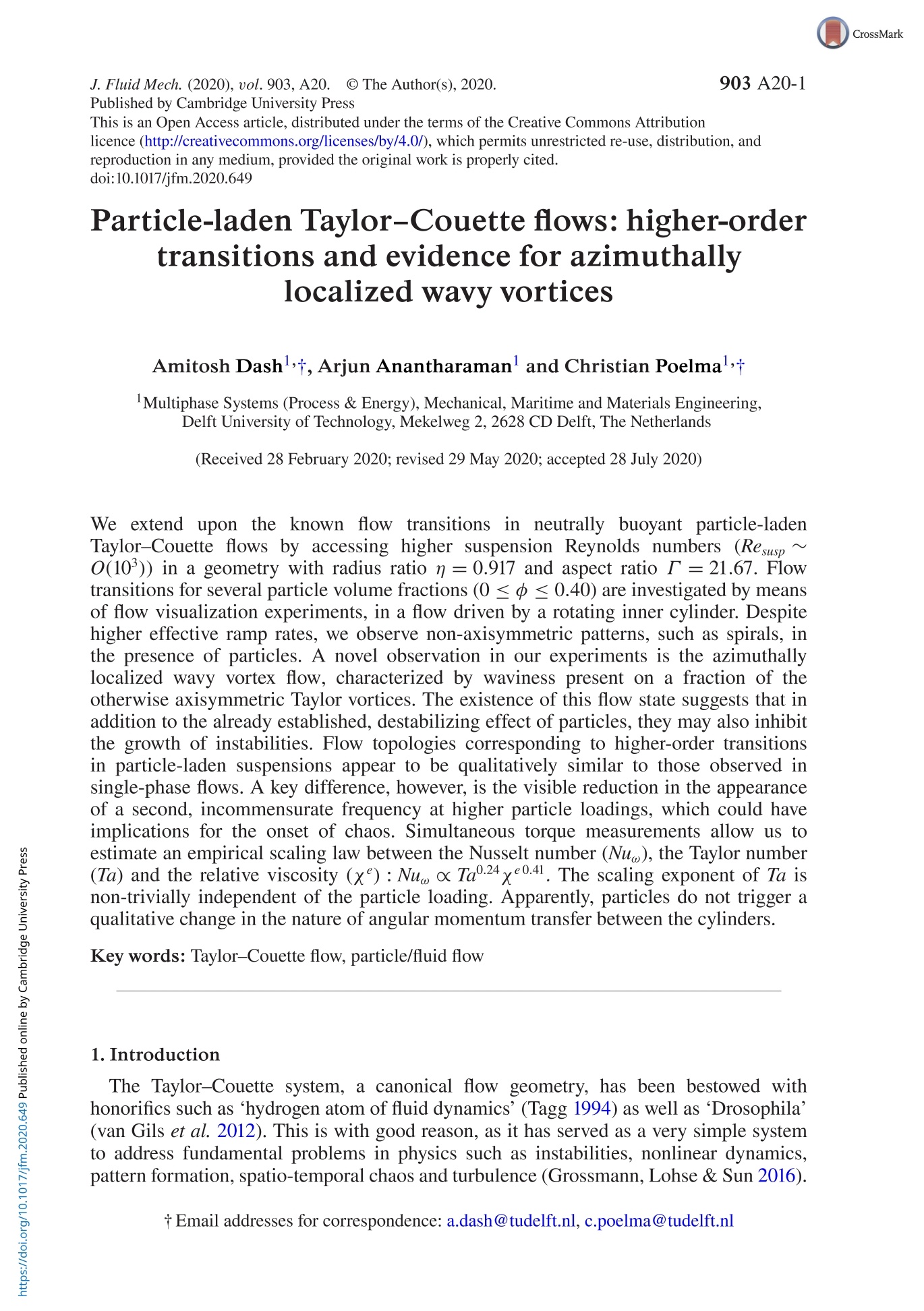
-
2/35
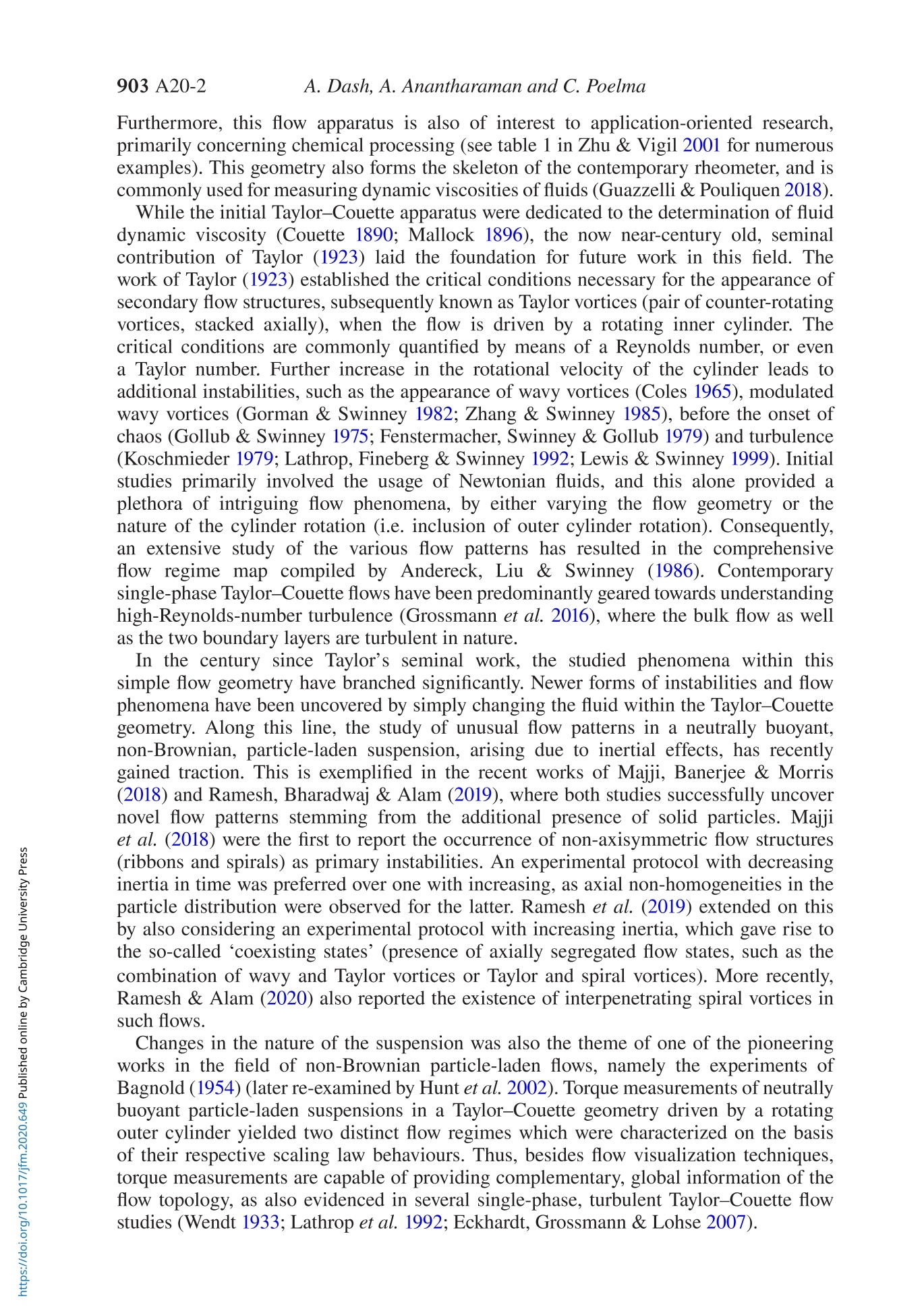
还剩33页未读,是否继续阅读?
继续免费阅读全文产品配置单
北京欧兰科技发展有限公司为您提供《Particle-laden Taylor-Couette流:高阶转变和径向局部波浪涡旋的证据》,该方案主要用于航空中流体速度场检测,参考标准《暂无》,《Particle-laden Taylor-Couette流:高阶转变和径向局部波浪涡旋的证据》用到的仪器有德国LaVision PIV/PLIF粒子成像测速场仪、LaVision DaVis 智能成像软件平台。
我要纠错
推荐专场
相关方案


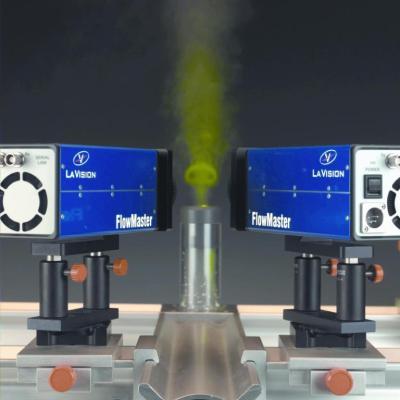
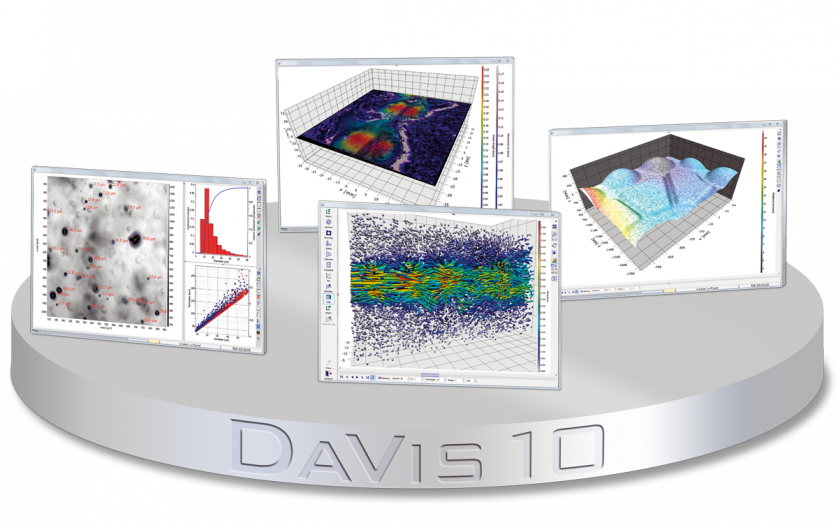
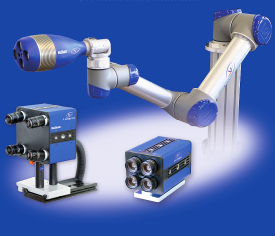
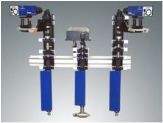



 咨询
咨询




